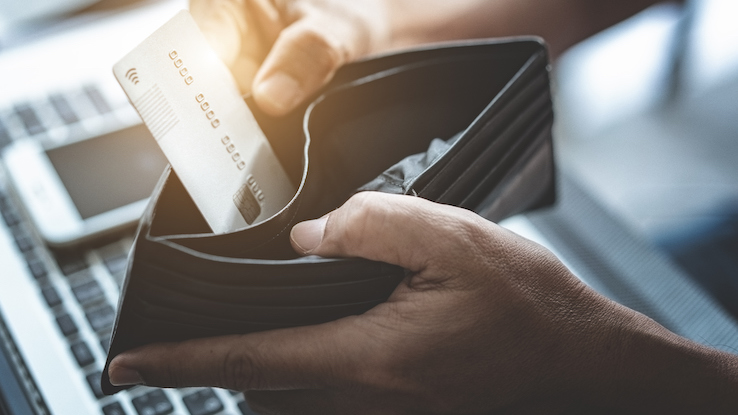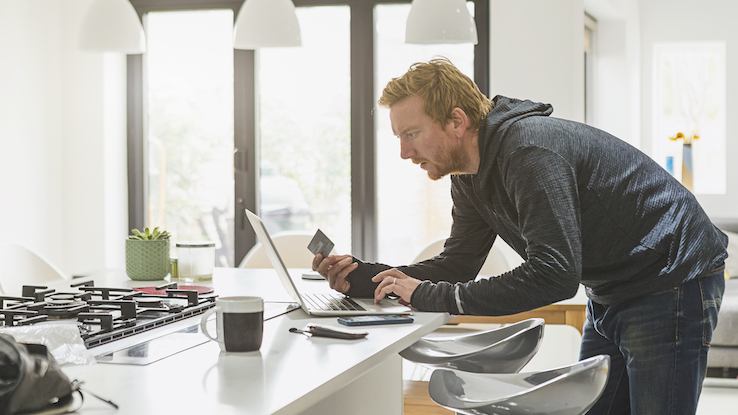If I Receive Social Security Disability Where Can I Go Online to Get a Loan

Paying bills and shopping online are convenient and fun ways to take care of personal business and to get the things you need and want. But — as is the case any time you enter personal information online — making purchases on the internet can put your details, like your name, address, phone number and banking numbers, at risk. To keep this information from ending up in the wrong hands, it's important to pay online safely and smartly. Use these tips to keep your online payments more secure.
Avoid Using Public Wi-Fi — or Stay as Safe as Possible on It
Public Wi-Fi networks may be convenient, but they can also be dangerous. These free internet access points are common in coffee shops, hotel lobbies, restaurants and even local retailers, and you can hop onto them easily when you don't want to use up your phone plan's data while you're out and about. However, public Wi-Fi networks are unsecured, meaning anyone can use them — including hackers. Hackers can access unsecured devices on unsecured networks, meaning they can intercept information you send out — like payment details. They can also distribute malware that damages your device.

It's best to wait until you're at home using your own password-protected Wi-Fi to make your payment. But if you do need to use public Wi-Fi to pay, avoid using an app (like a shopping or banking app) to do so — it's harder to be sure that apps are secure. Instead, use your phone's internet browser. Before you input your payment information, make sure that the website is fully encrypted. This means it scrambles your data before transmitting it so hackers can't "read" it. You'll know a website is encrypted when its URL begins with "https" instead of just "http." The Federal Trade Commission recommends making sure every page you visit is encrypted, not just your payment sign-in page.
It may be tempting to use your debit card to make online payments — the amount is deducted from your bank balance, which helps you stay more current on actual funds you have available. But it's not the wisest idea to pay with debit. If a hacker gets ahold of that card information, any money they spend using it will come directly out of your bank account. And while you'll have some recourse if this happens and can get that money back eventually if you report it quickly enough, having a chunk of your cash tied up until the matter is resolved can put unnecessary strain on your finances.

Instead of using a debit card, consider using a credit card if you have one. Credit cards typically have more fraud-protection features than debit cards, including zero-fraud liability, which means you're not on the hook for paying back any fraudulent charges. Credit card companies also often put a fraudulent transaction on hold while they investigate it, meaning it won't impact your statement balance.
Don't have a credit card? You can still make payments online in a way that may feel even safer to you. Using a prepaid Mastercard or Visa card works similarly to using a credit card — it has its own number, expiration date and other details that you can put into the same fields of the checkout page where you'd typically add your debit or credit card information. Even if someone were to get ahold of the card information, they wouldn't be able to spend more than the preloaded amount. The primary downside of these cards is that they aren't accepted at as many online retailers or in as many payment portals as debit and credit cards.
Take Care With Automation and Accounts
You might have some online accounts that have automatic or standing monthly payments, and in these cases you likely have your billing and payment information stored in each online profile for the site you're using. It's important to be aware that there's a risk in doing this. If this data is involved in a breach and hackers obtain it, they might have access to everything from your address to your credit or debit card numbers.

While opting not to store your payment information in online profiles and accounts is one of the better ways to keep it safe, it can be difficult to give up the convenience of not having to remember to make payments on time each month. If you prefer to keep your automated payments going, there are a few things you can do to be safer about it.
Start by using a credit card, not a debit card, as your preferred form of payment. You'll have access to its fraud-protection features should someone obtain the number. It's also helpful to ensure your password is secure and strong. This doesn't mean you need to change it frequently — in fact, experts recommend that you don't change it unless you think it's been compromised, it's weak, you shared it with someone or it'll make you feel safer to change it.
Use different passwords for each profile or account you have. This way, if someone gains access to one of your accounts and its password, they won't be able to access others by attempting to use that same password to get in. If it's an option, turn on two-factor authentication for your payment accounts as well. This means you'll only be able to access your account after providing two pieces of evidence that verify who you are — usually your account password and something like a one-time code that's emailed to you or sent in a text message.
MORE FROM QUESTIONSANSWERED.NET
If I Receive Social Security Disability Where Can I Go Online to Get a Loan
Source: https://www.questionsanswered.net/tech/how-to-make-online-payments-securely?utm_content=params%3Ao%3D740012%26ad%3DdirN%26qo%3DserpIndex
0 Response to "If I Receive Social Security Disability Where Can I Go Online to Get a Loan"
Post a Comment